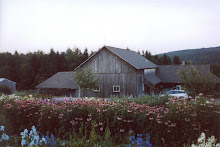
Hi everyone-
Cleanup and winterizing continues at Lucky Moon. Now that we've finally had a few sunny, dry days, we were able to get the garlic planted for next year. 3 beds, 4 rows per bed, and 120 cloves per row: that's 1,440 garlic plants for next year! And boy, is it tasty....
So, I wanted to give a little description/explanation of what a CSA is and how it works, in case any of you might be interested in joining for next year.
CSA stands for Community Supported Agriculture, and is also called Subscription Farming. It's essentially a way for farmers and consumers to interact directly, without the produce having to go through all those middle men before it reaches your table. Members of the CSA sign up and pay for a share of the harvest at the beginning of the season, and then the farmer provides those members with a box or a bag of fresh produce once a week. By paying for the vegetables up front, the members ensure that the farmer has enough funds to purchase the seeds, tools and natural soil amendments that he or she needs to grow the crops. It also means that the CSA members and the farmer share the risk of a crop doing poorly due to weather, disease or insect problems. However, shortfalls are pretty rare and more often than not, members end up getting extra produce when a crop does better than expected.
I really like subscription farming for lots of reasons. My personal favorite is that as a member, you can see for yourself exactly how your food is grown. Eating real food, grown by someone you know in your own community, makes a big difference when you consider all the repercussions of our country's current method of growing and transporting produce. Whether you're concerned about ingesting chemicals from industrial herbicides or pesticides, or you are aware of the incredible amount of oil that goes into petroleum-based fertilizer, or the effect of the chemical run-off from industrial farms on surrounding ecosystems, the CSA system offers a sustainable alternative.
And even if none of those issues really influence your eating choices, you simply have to taste the difference when a tomato or a carrot or lettuce isn't shipped all the way across the country (or from a different hemisphere!) Eating produce grown a few miles away and harvested the day you pick it up is an experience that too few of us enjoy these days. The difference in flavor and texture is incredible!
So that's my spiel- Subscription farming offers a sensible (and tasty!) alternative to the produce section of the average chain grocery store, and it helps you and your family get reconnected with the land. Knowing where your food comes from and how it's produced is really important. We are eating this stuff, after all.
If you're interested in joining the CSA for next year, or want to find out more about Lucky Moon's program, please contact me by email or give Sue and Claude a call.

Nicely written Sarah, Kudos! what kinds of veggies did you grow this year? Our garden was less than we had hoped, so we may have to supplement next year...We're also looking for locally raised beef, but that's another blog - just thought I'd throw it out there to see if you know of anyplace you'd recomend. Karen C.
ReplyDeleteI'd check out the website www.localharvest.com and search for your area code. There's a place in Tully called Creekside Meadows that raises beef, but I haven't actually been there. There is also a new Mennonite-run store in Fenner (Troyer's Country Store, I think) that sells beef from reliable sources. Andrew and I are currently semi-vegetarians (meaning we haven't bought meat for ourselves in a long time) so I'm not really up on the organic meat market.
ReplyDelete